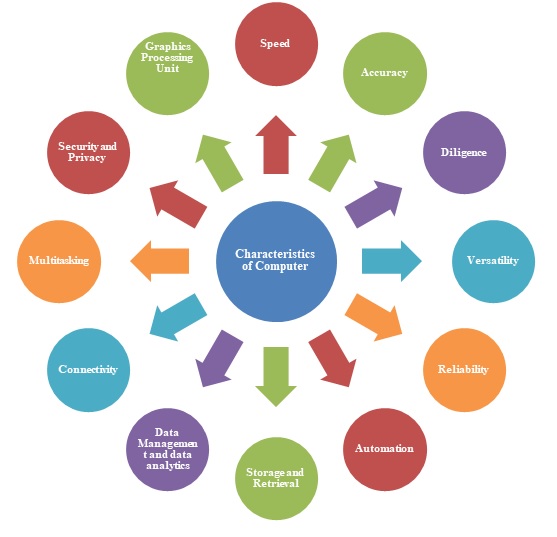
- Computer Fundamentals
- Computer - Home
- Computer - Overview
- Computer - Advantages & Disadvantages
- Computer - Classification
- Computer - Applications
- Computer - History and Evolution of Computers
- Computer - System Characteristics
- Computer - Origins
- Computer - Generations
- Computer - Types
- Computer - Components
- Computer - CPU
- Computer - Input Devices
- Computer - Output Devices
- Computer - Memory Units
- Computer - Hardware
- Computer - Motherboard
- Computer - RAM
- Computer - Read Only Memory
- Computer - Software
- Computer - Software Types
- Computer - Data Storage and Memory
- Computer - Memory
- Computer - Internet and Intranet
- Computer - Internet
- Computer - Extranet
- Computer - Websites
- Computer - Spread Sheet
- Computer - Power Presentations
- Computer - Ports
- Computer - Number System
- Computer - Number Conversion
- Computer - Data and Information
- Computer - Networking
- Computer - Operating System
- Computer - Keyboard Shortcut Keys
- Computer - Antivirus
- Computer - How to Buy?
- Computer - Available Courses
- Computer Useful Resources
- Computer - Quick Guide
- Computer - Useful Resources
- Computer - Discussion
Computer Fundamentals - Characteristics
The characteristics of the computer system are as follows −

Speed − A computer can process millions (1,000,000) of instructions per second. The time taken by computers for their operations is microseconds and nanoseconds. Hence, a computer works with high speed during the execution of Mathematical & logical computations.
Accuracy − Computers perform calculations with 100% accuracy. Errors may occur due to data inconsistency or inaccuracy. High accuracy indicates that a computer is performing its tasks correctly and producing reliable results. 100% accuracy depends on algorithm, data quality, hardware connectivity, and inherent uncertainties in the tasks being performed.
Diligence − A computer can perform millions of tasks or calculations with the same consistency and accuracy. It doesn’t feel any fatigue or lack of concentration. Hence, it can perform repetitive task without getting tired.
Versatility − Versatility refers to the capability of a computer to perform different kinds of works with same accuracy and efficiency. Hence, a versatile computer can be used for different purposes. A versatile computer can support Software Compatibility, Operating System Support, Programming and Development, Multi-Tasking, Internet Connectivity, Media Handling, Hardware Compatibility, Customization, and can manage different types of applications and workloads.
Reliability − A computer is reliable as it gives consistent result for similar set of data i.e., if we give same set of input any number of times, we will get the same result. Reliability is important to ensure safety, data integrity, and continuous operation. Reliability of a computer can be measured using Mean Time between Failures (MTBF), Mean Time to Failure (MTTF), Mean Time to Repair (MTTR), Availability (proportion of time a system is operational and accessible), and Failure Rate, Fault Tolerance(continuity of functioning even in the presence of hardware or software faults).
Automation − Computer performs all the tasks automatically i.e. it performs tasks without manual intervention. The main aim of automation is to improve efficiency, accuracy, and consistency in different processes by reducing manual intervention in the system. Automation can lead to increased productivity, reduced errors, and cost savings.
Storage and Retrieval − Memory is a storage device which stores data. The beauty of a computer is to execute the data in primary memory (RAM) whenever required. At the other side, data can permanently store to the secondary memory (Hard Disk) to the long time and a user can access it whenever they required; it does not delete the data until a user delete it.
Data Management and data analytics − In digital world, data can be in various forms, such as text, numbers, images, audio, and video. A computer may process and manipulate this data efficiently and provides insightful results from text, numbers, images, audio, and video data. The analytical results are used in decision making and useful to frame the strategies for the organisations.
Connectivity − The connectivity of computers enables data communication, resource sharing, and remote access to information and services.
Multitasking − Modern computer systems support multitasking, which means parallel execution of tasks. During multitasking process, processor rapidly switches between tasks, and giving the illusion of simultaneous execution. Multicore processors enable simultaneous execution of multiple tasks.
Security and Privacy − Modern computers are kept the data security, privacy of data to protect against unauthorized access, data breaches, and cyberattacks. For example -Biometric authentication, encryption, and secure boot protect the computer and user data.
Graphics Processing Unit (GPU) − GPUs manages graphical tasks like gaming, multimedia, and computational related things like AI and machine learning.
To Continue Learning Please Login